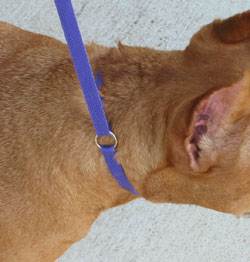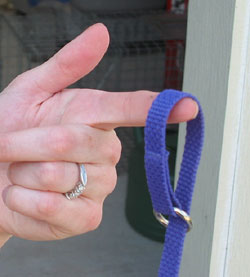What Type of Collar is Best for Your Dog?
Flat buckle, limited slip, choke chain, head halter, harness... the variety of collars and "walking tools" (collars and harnesses used to faciliate a casual walk) can be mindboggling, and it's not always clear whether a particular type of collar will work for you and your dog. Some dogs prefer to pull their owners down the sidewalk, and this can make walking an unpleasant trial rather than an enjoyable experience.
As an owner with not one but two irrepressable "pullers" (one of which has been deemed an "incurable puller" by a trainer), and as a very tiny, wimpy, lazy person to boot (I outweigh the larger by a mere twenty pounds), I have personally been through a whole host of collars and harnesses trying to find something that keeps our walks pleasant and easygoing. Here I'll share my knowledge with you to guide you through the sea of possibilities and, hopefully, find something that works for you and your dog without spending tons of money and ending up with a cabinet full of useless items.
However, I recommend that for best possible results, if you are really having difficulties, that you consult with a trainer or canine behaviorist for assistance. Many of these collars and training tools can be tricky to put on and use the right way, and can put your dog's health (or behavior) at risk if misused. Expert guidance can be a real time and money saver.
Everyday Collars
Shop Online for Everyday Collars
These shops support responsible dog ownership and do their part to improve the pit bull's rep. |
| Paco Collars - custom-made quality leather collars with silver ornaments and studs |
| Blocky Dogs - custom-made, thick, tough nylon collars, including limited-slip |
| Got one to add? Email me. |
Every dog needs an "everyday" wearable collar that can hold its identification tags, just in case. Even if your dog is an indoor dog, your house isn't an impenetrable fortress. Someone might break in, or a fire might break out, and in the commotion your dog might run away.
If you crate or kennel your dog, carefully examine both crate and collar to make sure the collar can't catch on any part of the crate and possibly choke your dog. Many people advise against a dog wearing a collar while it is in a crate because it may be possible for the dog to strangle itself by getting the buckle or tags caught between wires or in a door hinge. However, I think this depends on how you contain your dog while you're not home; for example, my elderly dog has a soft mesh crate that does not have openings where anything could get caught. I would rather that my dogs wear their IDs in case of an emergency. You may wish to consider microchipping your dog if you prefer to remove the dog's collar sometimes; that way, the dog always has identification, even without a collar.
Collar materials: For a large dog, you really only have two materials that will be strong enough: nylon or leather. Nylon collars are the most common and least expensive; you can find these at any pet store. Leather is a little harder to find (especially without spikes) and tends to be expensive, but it looks good and is very strong.
Collar size: For pit bulls and other large dogs, a wide (1" to 2") collar is best. To determine the proper collar length, wrap a cloth tape measure around the dog's neck where his or her collar usually sits. Don't pull too tight, but there shouldn't be any looseness in the tape measure either. If you don't have a cloth tape measure, you can use a piece of string or ribbon, then hold the string against a ruler to get the length. Most pit bulls are going to need collars that are 22" or longer.
Buckles: Plastic buckles "snap" together easily and are currently popular, but they are weak; don't expect the buckle to hold if you are trying to restrain a strong puller. Get a collar with a metal buckle if your dog is strong.
|


|
Flat buckle collar
The flat buckle collar is the most common type of dog collar. It comes in a variety of materials, colors, sizes, and buckles. This type of collar is a perfect "everyday" collar for a dog.
Please do not buy a collar with spikes for a pit bull. First, a spiked collar makes the dog look dangerous, and this reinforces the "vicious pit bull" stereotype. Second, it's not exactly comfortable for the poor dog.
Some guys (like my husband) simply aren't wild about the colorful cutesy collars flooding the pet stores nowadays. But if you are willing to look at a specialty store or online, there are some nice "masculine" collars out there that don't make your dog look like a dangerous outlaw; for example, check out Dozer's collar (left, bottom). I like this collar because it makes him look like one of the "good guys" rather than a scary freak.
If you have a dog that pulls very hard when you walk him, a flat buckle collar probably won't solve your problem; you will need a special collar or training device in conjunction with loose-leash training. However, the ultimate goal of loose-leash training is to produce a dog that walks nicely on leash with only a flat-buckle collar. |
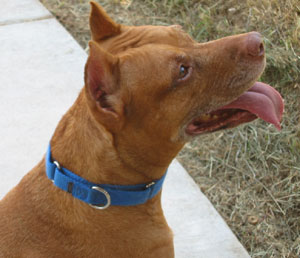


|
Limited-slip, greyhound, or martingale collar
The limited-slip collar is usually made of a nylon material. It comes in a variety of colors. This collar can also be worn as an "everyday" collar but it must be fitted properly and used with some care.
The limited-slip collar slides over the dog's head and is then tightened to proper fit.
The limited-slip collar has some significant advantages over other types of collars. Unlike a "choke chain," which can tighten endlessly and possibly choke the dog, a properly fitted limited-slip collar has metal stops that prevent the collar from tightening very far (hence the term "limited slip"). When properly fitted, the limited-slip collar will not tighten enough to damage the dog's neck or windpipe, but it will tighten enough to keep the collar from slipping over the dog's head if the dog tries to pull back.
The collar loop also doubles as a convenient handle to restrain the dog (bottom left).
Both my dogs wore martingale collars for many years. I liked them because of the "handle" that allowed me to pull the dog close against my leg when necessary. Plus, they were thick and strong, and had no buckles to break.
At the local humane society where I volunteered as a dog handler, martingale collars were required for those of us who walked "higher level" dogs—dogs that were more difficult to manage because they pulled, lunged, or bolted.
The limited-slip collar can be used in conjunction with other training tools (see below) to teach a dog to walk on a loose leash. It is also extremely useful as a collar that a dog cannot "back out" of (slip over its head), so you will never find yourself standing there staring at a leash with an empty collar while your dog bounds down the street unrestrained. |
Training collars and tools
These types of collars or harnesses are not for everyday wear. When you are not walking your dog, these collars/harnesses need to come off. It may be dangerous or deadly to leave these on your unattended dog.
The goal with these training devices is, ultimately, not to have to use them at all. You should use these in conjunction with loose-leash training in order to teach your dog how to walk politely at your side. Then, ideally, you should be able to "wean" your dog off of the training collar or harness and onto a flat collar. These devices are effectively a temporary or stop-gap solution that prevents the dog from pulling so that you can break the bad habit (pulling) and teach a new habit (loose-leash walking). However, some owners, myself included, use these tools as a matter of routine, either because loose-leash training doesn't work (as in the case of my so-called "incurable" puller, Felanie) or because the tools are more convenient and reliable than loose-leash training (as in the case of my dog Dozer, who doesn't pull unless he really pulls, and then I feel more comfortable being able to physically control him rather than rely on some tenuous faith that he will be obedient in what is probably a high-stress situation).
Every dog is different; none of these training devices are "right" for all dogs, and none of them are "wrong" for all dogs. It may take you a while to find the tool that works for you. I strongly recommend professional assistance for proper fitting and usage of these devices, as well as the correct method of loose-leash training that should be employed in conjunction with the particular tool. Used improperly, some of these tools can injure, frighten, or stress your dog; this could make your dog's behavior even more difficult to manage. With expert assistance, loose-leash walking will be much easier to achieve. |
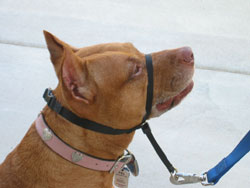
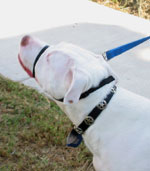
|
Head halter (Gentle Leader, Halti)
A canine head halter works along the same principles of gentle pressure and leverage as a horse halter. The nylon device loops over the nose and buckles behind the ears. The leash clips to a loop under the muzzle. When the dog pulls forward, the owner can pull back, and this brings the muzzle down or to the side (bottom right photo), making forward motion impossible for the dog.
The head halter can be difficult to fit properly. It should resemble a "V" (v for "victory") rather than an "L" when the dog is wearing it correctly.
The head halter is the only thing that stops my "incurable" puller. I can literally walk my seventy-five pound dog with one finger; she cannot pull at all while wearing the head halter.
However, the head halter is not a good option for all dogs. The halter requires some acclimatization, and initially the dog may react strongly to it. If not carefully desensitized, they may bolt, jerk, jump, and paw at the halter in an attempt to get it off. Most dogs will recover and accept the halter after repeated pleasant experiences with it. However, some dogs are so distressed by the halter that they may refuse to walk while wearing it.
Also, a few strong, determined pullers may put so much pressure on the halter that the nose loop can actually cut into skin and cause injury. (This was the case for my dog Dozer.)
For some dogs, the head halter seems to irritate the eyes.
Dogs with very short muzzles (i.e. Boxers, English Bulldogs) should not wear a head halter; the nose loop will slip off, and it may cause damage to a brachycephalic dog's nose.
Some people confuse the head halter for a muzzle, but it is not a muzzle. The dog can still open and shut its mouth quite normally and is still capable of biting. However, the halter can be used to draw the mouth shut temporarily. |



|
The Easy Walk harness
There are a variety of harnesses out there. Some harnesses actually facilitate pulling (after all, what does a sled dog wear?), but a few types use leverage strategies to prevent the dog from pulling.
Harnesses with leash loops on the dog's back are generally not effective at preventing pulling. This is because the dog is free to throw its weight against the harness chest band, and the person walking the dog then has to pull back against the dog's weight.
The Easy Walk harness has a loop on the chest where the leash hooks. When the dog pulls forward, the pressure turns the dog's chest to the side and stops the pulling. The harness also hinders jumping and lunging behaviors.
Dozer is modeling the Easy Walk harness. Notice in the bottom photo how he is being pulled sideways as he tries to go forward. I'm in the background standing still. I don't have to put very much pressure on the leash at all.
This type of harness can irritate skin under the dog's front legs. Some owners have cut moleskin pads to wrap around the harness where it rubs. |
|
"Choke" collar or slip lead
The choke collar is typically made of a linked metal chain. Though I used to own one, I don't anymore, so I couldn't model it. However, as common as it is, I don't think many people need a visual aid.
The slip lead (left) is a nylon or cloth strip that acts as collar and lead, and is often used in veterinary or animal control fields where a collar-leash combination is not practical. The mechanism is similar to a choke chain, so I'm including it here.
The choke collar has some major disadvantages. Though it used to be a staple training tool (and some "old school" trainers still use it) , it is generally avoided by modern trainers.
First, if used improperly, it can cause serious damage to the dog's neck, throat, and windpipe. The choke chain will tighten to an infinite degree (left, bottom). Dogs have been strangled and killed by this type of collar. A lot of owners don't realize that there is a right and a wrong way to put this collar on. It should go over the dog's head so that, when you face the dog, the collar makes a "P" shape, with the dangling bit (where the leash attaches) hanging over the left side of the head. If it makes a "q" shape, it's been put on incorrectly.
Second, most people have no idea how to properly use this type of collar. Typically, the choke collar is used to issue a brief, firm, immediate correction. It should sit high on the head, just behind the ears. You must know when to correct, and what to do immediately after issuing the correction. However, most people use it to choke the heck out of the dog as it yanks, drags, and retches its way down the sidewalk. This is not the way this collar is meant to be used!
And third, many pit bulls and other dogs with muscular necks and chests simply don't respond to corrections and pressure on the throat area. It doesn't really bother them, or perhaps they are too driven and determined to get the most out of their walk, and they're not going to let a little thing like pain get in the way of that. |
|
Prong or pinch collar
If the choke chain and the limited-slip collar had a baby, it would probably look like this. The prong collar, like the choke chain, is made of metal links. Unlike the choke chain, the prong collar is limited-slip, meaning it only tightens a certain amount before stopping. The prong collar uses metal spikes (prongs) that pinch the dog's neck when the collar tightens.
The prong collar looks painful but, when properly fitted and used, can be very effective for some dogs, particularly big, strong dogs. However, it is too harsh for timid dogs. Additionally, as with the choke chain, you must understand when and how to correct, and what to do after the correction. Once again, unfortunately, it seems that many owners do not understand how to use this tool correctly, and instead prefer to let the dog yank and drag and hack its way along.
This is one training tool for which I would definitely recommend getting professional assistance.
As a side note, I personally don't like these collars on pit bulls because they look rather scary. It seems to reinforce the idea that pit bulls are so ferocious and unmanageable that the owner actually has to inflict serious pain before the wild beast will submit. |
|




















